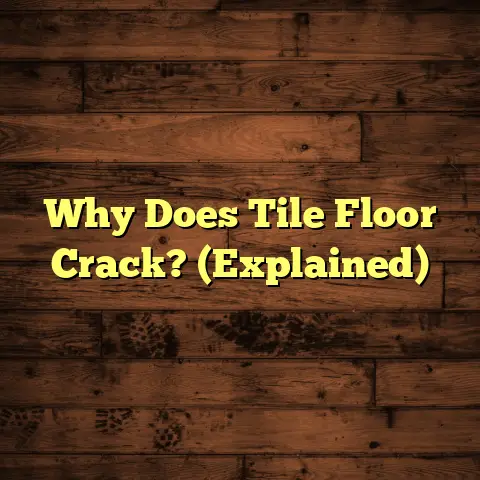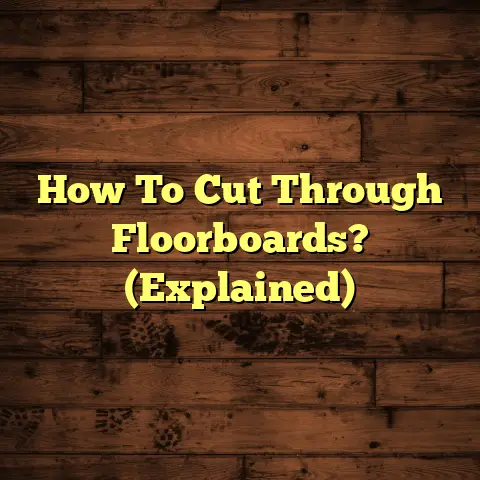Safely Removing Old Tile Flooring Without Damaging Subfloor? (Explained)
Did you know that improper tile removal can lead to costly damage to your subfloor? It’s true! As a flooring contractor with years of experience, I’ve seen too many homeowners and DIY enthusiasts jump into this task without a clear plan, only to end up facing expensive repairs later on.
Removing old tile flooring may seem like a straightforward task. However, it requires careful planning and the right tools to avoid damaging the subfloor underneath. I remember my first major tile removal project—it was a mix of excitement and dread. I had a client who wanted to replace a dated kitchen floor. As I started the job, I quickly realized how critical it was to handle the old tiles carefully to protect the subfloor.
Gathering Your Tools
Before you get started, let’s talk about what you’ll need. Here’s a handy list of tools I always prepare:
- Utility Knife: For cutting through any adhesive.
- Pry Bar: Essential for lifting tiles off the subfloor.
- Hammer: A good, heavy hammer can be your best friend.
- Floor Scraper: Helps remove residual adhesive effectively.
- Dust Mask and Safety Goggles: Safety first! Protect yourself from dust and debris.
- Gloves: To keep your hands safe from sharp edges.
- Chisel: Useful for stubborn tiles that just won’t budge.
- Heat Gun: Helps soften adhesive for easier removal.
- Shop Vacuum: To clean up dust and debris effectively.
With these tools in hand, you’ll be well on your way to safely removing that old tile.
Assessing the Tile and Subfloor
Before diving into removal, it’s crucial to assess both the condition of the tiles and the subfloor beneath them. Are the tiles cracked or loose? Is the adhesive still strong? Understanding these factors will dictate your approach.
For instance, on one project, I encountered tiles that were firmly adhered but had some cracks. I knew this would require more effort, but thankfully, my experience taught me that patience pays off. I took my time to remove each tile carefully. This meticulous approach ensured that the subfloor remained intact.
Step-by-Step Process
1. Prepare the Area
Clearing out any furniture or appliances from the room is your first step. Create a comfortable working space where you can move around easily. I remember one job where I didn’t clear out enough space, and it ended up being a hassle.
2. Score the Grout Lines
Using your utility knife, score along the grout lines between tiles. This step helps to weaken the bond between tiles. It’s a small detail that can make a significant difference in how easily the tiles come up.
3. Start Lifting Tiles
Insert your pry bar under the edge of a tile and gently tap it with a hammer if needed. Work slowly, and if a tile doesn’t budge, score it again or adjust your angle. There’s no rush here—taking your time will prevent damage.
4. Remove Adhesive
Once you’ve lifted a tile, use the floor scraper to remove any adhesive left on the subfloor. This process can be tedious, but it’s crucial for a clean surface. If you skip this step, it can lead to complications when installing new flooring.
5. Check for Damage
As you go along, regularly check the subfloor for any signs of damage or moisture. Addressing these issues early can save you headaches later.
Dealing with Challenges
Throughout my career, I’ve faced numerous challenges during tile removal. One particular job involved removing tiles from a bathroom that had been installed with an industrial-grade adhesive. It was a nightmare! I spent hours trying to lift those stubborn tiles without damaging the plywood subfloor underneath.
I learned that having a heat gun on hand can be incredibly helpful for softening adhesive. By applying heat to tough spots, I was able to lift more tiles without causing damage.
Another challenge came from an unexpected source: an old underlayment that was also glued down. This added another layer of complexity to the job; however, with patience and persistence, I managed to remove everything without causing any damage to the subfloor.
Cost Estimation with FloorTally
When it comes to budgeting for flooring projects, cost estimation is key. I rely on FloorTally to streamline this process. This tool provides accurate estimates based on local material and labor rates, making it easier for me to present realistic budgets to clients.
For example, during a recent project where I removed tile and replaced it with hardwood, FloorTally helped me break down all costs—ranging from disposal fees to new material costs—so my client could see where every dollar went.
Having transparency in pricing builds trust with clients. They appreciate knowing what they’re paying for and why. Plus, it allows for better financial planning throughout the project.
Tips for Success
Based on my experiences, here are some actionable tips:
- Take Your Time: Rushing through this process can lead to mistakes and damage. Allow yourself plenty of time to work carefully.
- Work in Sections: Instead of trying to tackle the entire floor at once, work in manageable sections. This approach helps keep things organized and less overwhelming.
- Stay Safe: Always wear protective gear. Dust and sharp edges are common hazards during tile removal.
- Consider Professional Help: If you encounter unexpected issues or feel overwhelmed, don’t hesitate to call in a professional. It can save you time and money in the long run.
Maintenance After Removal
Once you’ve successfully removed the old tile and ensured your subfloor is intact, it’s time to prepare for whatever flooring comes next. This is where maintenance becomes vital.
- Inspect the Subfloor: Ensure there are no signs of moisture or damage before installing new flooring. If needed, repair or replace damaged sections.
- Clean Thoroughly: Remove all dust and debris from the area. A clean workspace is essential for proper installation of new flooring.
Comparing Options
When I think about flooring options after removing old tiles, I often weigh different materials based on durability, cost, and aesthetics.
For instance, if a client is looking for something cost-effective yet stylish after removing tiles, laminate can be a great choice. It’s affordable and comes in various designs that mimic hardwood or stone.
On the other hand, if they’re willing to invest more for longevity and value, I might suggest engineered hardwood or luxury vinyl plank (LVP). Each option has its pros and cons based on specific needs.
Understanding Subfloor Types
When tackling any flooring project, especially one involving tile removal, understanding different types of subfloors is crucial.
Plywood Subfloor
Plywood is commonly used in residential construction. It’s relatively easy to work with but can be susceptible to moisture damage if not properly sealed or maintained. When removing tiles from a plywood subfloor, it’s essential to minimize moisture exposure during the process.
Concrete Subfloor
Concrete is another popular subfloor material, especially in basements or commercial spaces. Removing tile from concrete can be more challenging due to its durability; however, using the right tools can help facilitate this process.
OSB (Oriented Strand Board)
OSB is often used as a cost-effective alternative to plywood. While it’s sturdy, OSB can swell when exposed to water—so extra caution is needed during tile removal to avoid damaging it.
Common Mistakes to Avoid
Through years of experience, I’ve noticed several common mistakes people make when removing tile flooring. Here are some key ones to watch out for:
- Rushing the Process: Taking your time is key; rushing leads to mistakes.
- Neglecting Safety Gear: Always wear gloves and goggles—safety first!
- Not Preparing Properly: Failing to clear out furniture and prep the area can lead to accidents.
- Ignoring Subfloor Condition: Not checking for moisture or damage before starting can cause bigger problems later on.
- Underestimating Adhesive Issues: Many people don’t realize how tough certain adhesives can be until they’re halfway through the process.
Tools and Techniques for Stubborn Tiles
Some tiles seem almost determined not to be removed! In these cases, having specialized tools can make all the difference.
- Tile Removal Hammer: A heavier hammer designed specifically for tile work.
- Electric Scraper: For those really tough jobs where manual scraping just won’t cut it.
- Oscillating Multi-Tool: Great for cutting through adhesive or grout without damaging surrounding areas.
Using these tools can save time and frustration when dealing with stubborn tiles or tough adhesive bonds.
What Happens if You Damage the Subfloor?
If you accidentally damage the subfloor during tile removal, don’t panic! Depending on the extent of the damage, several options are available:
- Repairing Small Areas: For minor damage, wood filler or patching compounds can work wonders.
- Replacing Sections: If larger areas are compromised, consider replacing those sections entirely.
- Consulting Professionals: If you’re unsure how extensive the damage is or how to fix it properly, calling in an expert could save you from bigger headaches down the line.
The Importance of Floor Preparation Before Installation
Once the old tile is gone and you’ve addressed any subfloor issues, preparing for new flooring installation is critical:
- Leveling: Use self-leveling compound if necessary to ensure an even surface.
- Moisture Barrier: Especially important if you’re installing over concrete; this helps prevent moisture issues in your new floor.
- Cleaning Again: Dust and particles can affect adhesion; make sure your workspace is spotless before laying any new flooring.
Final Thoughts on Tile Removal
Removing old tile flooring doesn’t have to be a nightmare if approached correctly. By preparing adequately, using the right tools, and taking your time, you can safely remove old tiles without damaging the subfloor underneath.
Every project has its own story—filled with successes and challenges alike—but with experience comes confidence. Whether you’re a DIY enthusiast or a seasoned contractor like me, remember that each job is an opportunity to learn and improve your skills.
As you take on your next flooring project—whether you’re removing tile or installing something new—keep these insights in mind. Roll up your sleeves and get to work; you got this!
And if you ever find yourself stuck or uncertain about anything along the way, don’t hesitate to reach out for advice or support from professionals like myself who have been there before!





